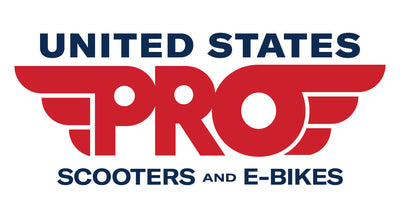ICS, SCS, HIC, & IHC - What Is The Difference?
Posted by SYEDA UME LAYLA
What's the difference? SCS, HIC, IHC, & ICS
What are we talking about when we are discussing ICS, SCS, HIC, and IHC? The answer is scooter compression, or the way your forks, bars, and deck are attached together on your scooter. A scooter compression system assists in minimizing the slack and rattling a trick scooter will accumulate over time. In other words, it helps reduce any bad movement within the neck of your scooter as well as preventing future mechanical wear to your scooter as a whole…
The compression systems we will discuss today are:
- ICS - Internal / Inverted Compression System
- SCS - Standard Compression System
- HIC - Hidden Integrated Compression
- IHC - Internal Hidden Compression
Which scooter compression system is the best?
SCS - Standard Compression System
SCS is the brainchild of PROTO owner, Andrew Broussard. He originally created this system to go against the standard of the time, the threaded fork and threaded headset. Using inspiration and hardware from BMX bikes, he replaced the old compression system with a threadless one that used a somewhat large clamp, with an internally held compression screw, that could house your forks with a smaller bore on bottom, and your bars with the larger bore on the topside. This created a strong, reliable, and relatively adaptable compression system that has become popular today.
With SCS, all you have to do is slide the clamp onto the fork (you may need a headset spacer depending on your parts), then tighten the compression bolt into the fork. After that, slide your bar into the top and tighten the four bolts of the SCS and you’re good to go. SCS is one of the strongest compression systems due to the fact that the bar does not need a slit. Most can also house either an oversized or standard bar with the correct shim.
One noted disadvantage is the size and weight of the SCS. But some companies have created a “mini” SCS while others opted to create smaller versions with three bolts instead of four. It also tends to be the most expensive of the builds as you need to have a compatible fork as well as the SCS itself.
If you have the budget, you’re looking for the strongest, most durable build but don’t mind the weight, SCS is the build for you.
HIC - Hidden Internal Compression
HIC was first created by the RAD Scooter Company, and is one of the first compressions to evolve past the standard threaded system. HIC was once the lightest, and simplest system available only consisting of a bolt, starnut, shim, and top cap. They are compatible with HIC/SCS forks, though an ICS fork can be modified as well. HIC can only be used with steel or titanium oversized bars with a slit cut into them.
With the HIC system, the shim goes over the fork, the top cap over that, then the bolt screws into the fork. This whole setup is housed within the bar and tightened with a clamp. It is important to note you must have a shim that is longer than the exposed portion of the fork, otherwise compression will not happen.
HIC systems are easy to build, and usually quite affordable. However, they do carry the similar weak point at the slit in the bar that the ICS does.
If you’re looking for a middle ground compression system, in both weight and durability that still touts a reliable compression, HIC may be the system for you.
IHC - Internal Compression System
IHC was developed by Envy/Blunt Scooters, and is essentially the standard size bar answer to HIC. The IHC system is more or less the same build as the HIC but made lighter and built for standard size steel and aluminum bars with a slit cut into it (and can adapt to an oversized bar with a conversion kit). IHC systems also use a fork with a smaller external diameter, decreasing the weight of the overall build. Some forks even have the compression system already built in.
IHC is an affordable, lightweight system that provides a pretty reliable compression. However, having one of the thinnest forks and still having the slit as in the HIC systems, there can be a tendency for the less durability overall. Also, because IHC is only manufactured by certain brands, looks and compatibility may be limited.
If you are not throwing heavy tricks, are looking for the lightest build, or are a smaller rider, IHC may be the compression system for you.
ICS - Internal / Inverted Compression System
ICS is well known to be one of the cheapest and lightest of the compression systems. It also ends up being one of the weakest and slightly more inconvenient to use. The ICS uses an inverted compression bolt, a long M6 bolt (or short with some alternative hardware), which goes up through the fork tube, screwing into an internally threaded star nut in the bar. This creates a compression of the bars against the fork, which then tightens the headset. This setup creates less of a need to tighten the clamp as tightly. While you can use a steel bar, an ICS tends to work better with aluminum bars. The steel star nut tends to slip inside steel bars, loosening the compression, whereas with softer aluminum, it can grip the inside sufficiently when compressed.
Inverted compression systems were the standard for many manufacturers years ago, but are not as popular currently. This is partially due to the disadvantages of this build. One disadvantage being that any time you would like to tighten this bolt, you have to remove the wheel. Another drawback is its overall durability; it is much weaker due to a couple of aspects. The first durability issue is that it is only held together by one long bolt which would be more likely to break than shorter ones. The other is that to use it, you can only use standard size bars that have a slit cut into it, creating a weak point at the bars.
If you are looking for an affordable, lightweight compression, great for aluminum bars, this may be the build for you, as long as you know the risks.
Ready to switch to SCS for your scooter?
Most pro scooters come with IHC which is super affordable and lightweight. Our recommendation of the first part to upgrade from a complete is the compression system. This upgrade is a much bigger task than you might think.
To switch from IHC to SCS you need a new fork, clamp,headset and bars. It’s worth noting you can keep your old bars and use a shim, but that goes against the point of SCS all together - the slit in the base of your bars is the weak spot.
We don’t want you to have to worry about compatibility issues so this list of recommendations is based on parts that should fit whatever you have on your set up.
Fork - Envy Declare V2 Fork
Headset - Envy Integrated Headset
Clamp - Envy Omen SCS Clamp
Bars - Envy Oversized Soul Bars
Make sure to grab all four of those items to have a successful SCS conversion. And as always, if you need help with anything feel free to reach out through any of our many forms of contact.
*Pro Tip*
The Envy KOS S7 Soul comes with SCS out of the box for a great price!

